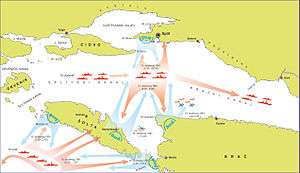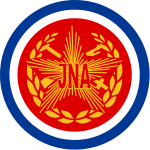Yugoslav frigate Split
 Yugoslav frigate Split (Bay of Kotor in 2008) | |
| History | |
|---|---|
| Name: | Split |
| Namesake: | City of Split |
| Builder: | A.M. Gorkogo Shipyard, Zelenodolsk, Russia |
| Acquired: | 10 March 1980 |
| Name: | RF-31 |
| Acquired: | 1992 |
| Decommissioned: | 2001/2005 |
| Fate: | broken up for scrap in 2013 |
| General characteristics | |
| Length: | 96.51 m (316.6 ft) overall |
| Beam: | 12.56 m (41.2 ft) |
| Propulsion: |
|
| Speed: | 27–28 knots (50–52 km/h; 31–32 mph) |
| Range: | 4,000 nmi (7,400 km; 4,600 mi) at 14 knots (26 km/h; 16 mph) |
| Endurance: | 10 days |
| Complement: | 123 |
| Armament: | |
Split (pennant number VPBR-31) was a Koni-class frigate acquired by the Yugoslav Navy (Jugoslavenska ratna mornarica; JRM) in 1980. Designated as large patrol boats with anti-submarine warfare and air defence capabilities, both Split and its sister ship Koper were eventually armed with launchers for four P-20 anti-ship missiles making them one of the best armed ships in the navy's inventory at the time.
During the Croatian War of Independence Split took part in the Battle of the Dalmatian Channels where it was noted for shelling the city of Split after which it was named.[1] With the withdrawal of Yugoslav Navy forces from Croatian territorial waters, Split, along with most of the fleets ships, was relocated to Montenegro. During the 1990s, it was redesignated as RF-31 and possibly renamed Beograd. The ship was decommissioned sometime between 2001 and 2005. After unsuccessful attempts of selling it as a complete warship, it was sold for scrap and broken up in 2013.[2]
Design and construction
During the 1970s the SFR Yugoslav Navy (JRM) was seeking surface ships to increase the overall firepower of its fleet, improving capabilities that were until then either obsolete or nonexistent on other ships in its inventory.[3]
Split was laid down in January 1978 at the A.M. Gorkogo Shipyard in Zelenodolsk as the fourth ship in its class (Projekt 1159). Launched on 21 April 1979, it was temporarily commissioned with the Soviet Navy on 30 November 1979 under the name Sokol. On 10 March 1980 it was acquired by the JRM for a price of 18.27 million dollars, given a new name, Split, and classified as a VPBR (hr. Veliki Patrolni BRod; en. Large patrol boat).[3][4]
Split measured 96.51 metres (316.6 feet) in length, had a beam of 12.56 m (41.2 ft) and displaced 1,590 tonnes (1,560 long tons) while fully loaded. Like other Koni-class frigates it employed a CODAG type propulsion combining a single M-8G 20.000 hp gas turbine with two 8000 hp diesel engines giving it a maximum speed of 27–28 knots (50–52 km/h; 31–32 mph)[3] Power was also provided by one 200 kW and two 300 kW diesel generators.[4] The ship had a range of 4,500 nmi (8,300 km; 5,200 mi) at 14 knots (26 km/h; 16 mph) and an endurance of 10 days.[4]
ASW weapons included two RBU-6000 launchers mounted side by side, controlled by the "Burya" fire control system with additional 120 rounds in storage, as well as twelve BB-1 conventional depth charges. Cannon armament consisted of two 76 mm AK-726 dual guns mounted on the ships' bow and stern with two AK-230 CIWS placed on the sides and controlled by the MR-104 "Ris" FCS. Air defence was provided by a single dual mount for the 4K33 "Osa-M" system with 20 additional missiles.[4][3]
Four stern facing launchers for P-20 anti-ship missiles were installed soon after the ship was commissioned with the JRM.[5]
Service

During the early stages of the Croatian War of Independence Split, often mistakenly referred to as a destroyer, served as the command ship of the Kaštela tactical group which was tasked with enforcing the naval blockade of the Croatian coastline and islands, playing a prominent role in the Battle of the Dalmatian Channels. As a sign of retaliation for sinking the patrol boat Mukos (PČ-176) a day earlier, in the morning hours of 15 November Split operating under the code name "Sava" along with other ships of the tactical group opened fire on the city of Split and the islands of Brač and Šolta.[3][6] As Croatian coastal artillery batteries started returning fire, some reports suggested that several JRM ships, including Split, were damaged.[3][7] This later proved to be false as all of the ships started retreating towards Vis with no visible damage.[3]
On 19 November Split was called in to rescue a convoy of overloaded JRM ships that was sailing from Pula to Vis across open sea during strong jugo winds. While rescuing the crew from one of the landing crafts, two sailors died because the ladder thrown to them from Split, accidentally hit them causing them to drown.[3]
After the retreat of all Yugoslav Navy forces from Croatia, Split was relocated to Montenegro where it was renamed Beograd in 1993[4] with its designation being changed to RF-31 (sr. raketna fregata; eng. missile frigate).
Decommissioning and aftermath
On 17 August 2001 the FR Yugoslav Ministry of Defence decommissioned the ships declaring it reduntant.[8] The ships was located within the "Sava Kovačevič" overhaul shipyard in Tivat until 2008 when it was berthed near a military object on Luštica. Due to the lack of any kind of maintenance, parts of the hull became corroded which resulted in several breaches so sea water needed to be pumped out from time to time.[2][9]
2004 marked the last time Split sailed on its own during a demonstration for the representatives of the Sri Lankan Navy who were interested in buying the ship. Although the deal was near done, the catastrophic 2004 tsunami and subsequent damage prompted the Sri Lankans to stop the acquisition of all new military equipment, including the purchase of Split.[9] In 2009 Split along with three other frigates was being sold for a price of 3.2 million euros, each.[10] In May 2011 the price for Split was reduced to 1 million euros, but again, no deals were made[8]
In 2010 divers from Herceg Novi proposed reaching an agreement with Croatia and sinking the Split on the sea border of the two countries where it would become a diving site. The act was also to have a symbolic meaning of peace because the ship became notorious in Croatia after attacking the city after which it was named.[11][9][12]
In October 2011 the Government of Montenegro adopted a document in which it was stated that attempts at selling the ship as a complete warship will stop, and will instead be sold for scrap.[8][13] Before the scraping took place, weapons systems, radio communication and other electrical equipment as well as two MTU 8V396 diesel generators that were installed in 1997 and 1999, were removed from the ship.[14] On 19 August 2013 Split was towed away to a ship breaking yard in Durrës after being sold to an Albanian company for 400.000 euros.[2]
See also
Notes
- ↑ Čolpa 8 October 2010.
- 1 2 3 Luković 21 August 2013.
- 1 2 3 4 5 6 7 8 Bernadić 2013.
- 1 2 3 4 5 Russian ships.
- ↑ Jelavić 2003.
- ↑ Baras 14 November 2011.
- ↑ Krnić 15 October 2013.
- 1 2 3 Government of Montenegro 10 December 2013.
- 1 2 3 Luković 30 October 2011.
- ↑ Krnić 30 October 2009.
- ↑ Bioča 14 September 2010.
- ↑ Kalajdžić 13 December 2010.
- ↑ Seebiz 30 October 2011.
- ↑ Luković 10 April 2012.
References
- Books
- News reports
- Luković, Siniša (21 August 2013). "Posljednja plovidba "Splita"" [Last sailing for "Split"]. Vijesti.
- Baras, Frano (14 November 2011). "HRT: Razarač Split razara Split" [Destroyer Split destroying Split!]. HRT.
- Čolpa, Marija (8 October 2010). "Presuda za sva zlodjela" [Conviction for all the atrocities]. monitor.me.
- Krnić, Denis (15 November 2013). ""S razarača su naredili paljbu po civilima, a gađali su i škole"; Baldasar odao počast na Lovrincu, u luci potopljeni vijenci" ["They ordered opening fire on civilians from the destroyer, shooting schools too"; Baldasar pays tribute on Lovrinac, wreath laid down into the sea]. Slobodna Dalmacija.
- Luković, Siniša (30 October 2011). "Najjači jugoslovenski ratni brod "Split" odlazi na dno mora ili u staro gvožde" [Yugoslavias strongest warship to be sunk or sold for scrap]. Vijesti.
- Krnić, Denis (30 October 2009). "Brod smrti - Crna Gora prodaje ubojicu Splićana" [Death ship - Montenegro to sell the killer of Splits' residents]. Slobodna Dalmacija.
- Bioča, Marko (14 September 2010). "Razarač na dnu mora: Splitski krvnik postaje podvodna atrakcija za ronilački turizam" [Destroyer on the sea bottom: Splits' executioner to become a underwater attraction for diving tourism]. Nacional.
- Kalajdžić, Ahmet (13 December 2010). "Poziv iz Crne Gore: "Kerume, spremili smo ti eksploziv, potopi razarač Split"" [Call from Montenegro: Kerum, the explosives are ready, sink the destroyer Split]. Slobodna Dalmacija.
- "Vlada Crne Gore proglasila Ratni brod Split sekundarnom sirovinom" [Government of Montenegro declares warship Split for scraping]. SEEbiz.eu. 30 October 2011.
- Luković, Siniša (10 April 2012). "Raketna fregata "Split" se sprema za posljednje putovanje" [Missile frigate "Split" getting ready fori its last journey]. Vijesti.
- Other sources
- "Prijedlog za rješavanje statusa broda Raketne fregate RF-31" [Proposal for dealing with the status of the ship Rocket frigate RF-31] (PDF). gov.me. 10 December 2013.
- Bernadić, Stjepan (October 2013). "Oproštaj bez zvuka sirene" [Farewell without the sounds of sirens]. Hrvatski vojnik (in Croatian). Ministry of Defence (Croatia) (432). ISSN 1333-9036.
- "Guard ships - Project 1159". russian-ships.info.
- Jelavić, Tino (December 2003). "Razmatranje o JNA" [Considerations regarding the JNA]. Polemos (in Croatian). VI (11-12): 167. ISSN 1331-5595.
